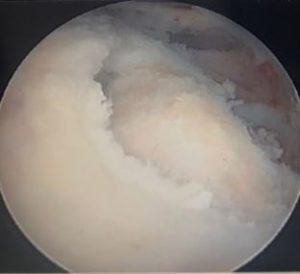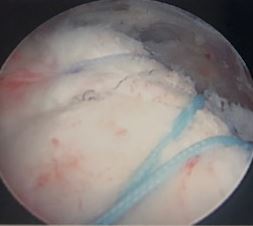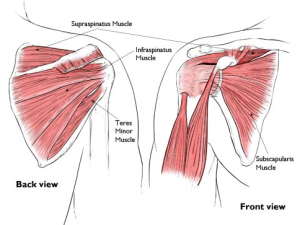What is the rotator cuff?
The rotator cuff is a group of 4 muscles that surround the shoulder joint. These muscles are the supraspinatus, infraspinatus, subscapularis, and teres minor. They function in many of the motions of the shoulder. They are found beneath the larger muscles of the shoulder, the deltoid and pectoralis major.
Signs & Symptoms of a Rotator Cuff Tear
These muscles can be torn as an acute injury or chronically with wear and tear. A rotator cuff tear can cause weakness with certain activities such as reaching. In addition to causing weakness, a tear can be very painful. Patients frequently complain about pain at night and with overhead activity.
An initial evaluation consisting of a history, physical examination, and imaging studies can help determine if a tear is present. An MRI can confirm a diagnosis of a rotator cuff tear, in addition to any other injuries of the shoulder.
Treatment for a Rotator Cuff Tear
Many variables are considered when deciding the best treatment options for rotator cuff tears. Some tears respond best to surgery and some can be treated conservatively, avoiding surgery. Some of these options include:
Non-surgical
Activity modification – Certain motions and activities can cause irritation of the rotator cuff and the overlying bursa. Minimizing these activities can speed up the recovery process as we strengthen the shoulder and decrease pain.
Anti-inflammatories – There is usually a component of inflammation contributing to the pain and weakness. Various forms of anti-inflammatories can treat this inflammation. These include OTC medications such as ibuprofen and naproxen (also known as NSAIDs), prescription medications such as a steroid pack, and topical creams. It is important to be cautious and avoid long-term use of oral NSAIDs as they can be associated with heart and stomach problems. They should be considered for short-term treatment to reverse inflammation and not as a long term solution.
Physical Therapy – This is usually the most important aspect of conservative treatment. Strengthening the rotator cuff muscles and the surrounding muscles of the shoulder is the key to regaining function and returning to pain-free use of your shoulder.
Injections – Steroid injections can be helpful in treating the associated inflammation with rotator cuff tears. These injections are considered a treatment, not simply a cover-up of the pain. Steroids are extremely effective at minimizing inflammation. While pain relief is a nice side effect, the primary goal is to reverse the inflammation and allow strengthening of the shoulder and return to normal function.
Rotator Cuff Tear Surgery
Surgical treatment is the best option in some cases. In others, it is recommended only after failure of non-surgical treatments.

Rotator cuff tear

After repair
Procedure:
This is an arthroscopic procedure (minimally invasive). This involves several small incisions around the shoulder. A camera is utilized to see the tear and instruments are utilized through other small incisions. Arthroscopic surgery uses small incisions which speeds up the recovery process and minimizes pain. The tear is identified and small plastic anchors with attached sutures are placed into the area where the rotator cuff should be attached. The suture is passed into the rotator cuff and tied into place. This reattaches the tendon to where it tore from and recreates the normal pre-injury anatomy of your rotator cuff.
It is common for patients to have a bone spur associated with a rotator cuff tear. This is usually smoothed out during surgery. After the rotator cuff is repaired, any additional problems are treated as diagnosed and discussed during our preoperative planning.
Logistics:
Rotator cuff repair is performed as an outpatient procedure, which allows you to return home the same day as surgery. General anesthesia is utilized in addition to a regional block. A regional block numbs the shoulder, preventing pain for approximately 24 – 36 hours after surgery. A block also minimizes the anesthesia required during the procedure, resulting in a lower risk of nausea after surgery. The procedure lasts approximately 1 – 2 hours.
Recovery:
The rotator cuff takes 3 months to heal back to the bone and it is very important to protect the repair during this time. We will walk you through each phase of the recovery process to ensure complete healing. This is personalized to the size and characteristics of your tear.
Weeks 1-6: Passive Motion Phase – An immobilizer is worn at all times except showers and therapy to protect the shoulder. All motion is done passively (without using the muscles). Physical therapy is usually started during this phase.
Weeks 7-12: Active Motion Phase – No more immobilizer. The goal of the phase is to regain full active motion of the shoulder. There are no limitations on motion. Therapy is very important during this phase. Lifting restrictions continue until 3 months after surgery.
Weeks 13+: Strengthening Phase – Time to build up the strength in the shoulder to get back to pain-free use of your shoulder.
Most of the improvements in function occur during the first 6 months, but will continue for the first year after surgery. While the recovery process is long, results of this procedure are very good. Most patients return to their previous activity levels without difficutly.
Click here to view the more detailed Rehabilitation Protocol
Diagrams modified from AAOS (www.aaos.org)

